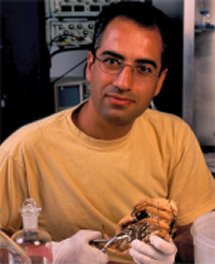Spotlight: Mathematical Biology Adds Up to New Physiological Insights
 March 25, 2004
March 25, 2004
Sure they taste great boiled and properly seasoned, but crabs may also hold the key to some of biology's most intriguing questions about rhythmic patterns in the central nervous system and what happens when those patterns become abnormal. Research into rhythmic neuron-firing patterns that activate muscles in the stomachs of crabs is one of about a dozen studies under way at NJIT's interdisciplinary Center for Applied Mathematics and Statistics that combine mathematical and biological techniques to determine how physiological systems function.
A crab's simple digestive system, says Farzan Nadim, associate professor of mathematical sciences, makes the crustacean an ideal research model. "Because a crab has only about 30 neurons involved in digestion, it is a good choice for studying the rhythmic pattern of fast and slow nerve impulses that activate the stomach muscles during grinding, chewing, digesting and filtering food," says Nadim. The researcher and his colleague, associate professor Amitabha Bose, use computational, analytical and experimental techniques to study the crabs. Nadim's research is funded by a five-year grant from the National Institutes of Health (NIH), and both researchers also have grants from the National Science Foundation (NSF).
"Through the work of mathematicians over the past 20 years, we now have general principles that show us that rhythmic patterns in most animals--including humans--are essentially the same," Bose points out. "Scientists have established that most species can perform several rhythmic motor activities simultaneously, such as walking, breathing, swimming and chewing. What we don't know yet is how these rhythmic activities are generated by neurons and why nerve cells sometimes begin to misfire and disrupt the normal oscillating fast-slow rhythmic pattern. Malfunctioning of these neuron-firing patterns leads to such abnormalities as epilepsy and Parkinson's disease.
Jorge Golowasch, an associate professor of mathematical sciences, also collaborates with Nadim in researching neural networks in crustaceans' stomachs. Using electrophysical and computational methods, Golowasch studies cellular and network mechanisms that enable neurons to recover from disruptions produced by growth and injury. With the help of NIH and NSF support, he is attempting to answer the question of how the nervous system can be flexible, or plastic, while at the same time remaining stable, which may shed light on mechanisms of learning and memory.
Expanding the spectrum of studies
Nadim, Bose and Golowasch are among the members of the Department of Mathematical Sciences and the Center for Applied Mathematics and Statistics who are pursing studies in mathematical biology, a field of applied mathematics that has been growing steadily in recent years. One of the largest concentrations of researchers working in mathematical biology in North America is to be found at NJIT, and their efforts have been supported by major external funding. To date, the funding that has been awarded by the National Institutes of Health, the National Science Foundation, the Whitaker Foundation, and other public and private sources amounts to nearly $2.5 million.
Research in mathematical biology spans a growing range of applications, including studies in animal and plant populations, physiology, biomechanics, epidemiology, disease pathology, neuroscience, hemodynamics, molecular biology, pharmacokinetics and cell physiology. Some examples of medical applications include the detailed study of the components of the brain, treatment of diseases, and the design of pharmaceutical devices for drug delivery.
In mathematical biology, equations and experiments go hand in hand. Accordingly, most mathematical biology studies are conducted by teams of researchers that include mathematicians who use analytical and computational models to propose a hypothesis and experimentalists who carry out the relevant experiments in their laboratories to test them. Some of the NJIT researchers are working independently while others are collaborating with experimentalists at Boston University, the University of California at Berkeley, the University of Michigan, New York University, the University of Wisconsin, and the University of British Columbia in Vancouver.
A model approach at NJIT
The expertise in mathematical biology marshaled at NJIT was one of the reasons Robert M. Miura, associate chair of the department of mathematical sciences and professor in mathematical sciences and biomedical engineering, decided to join the faculty two years ago after having been at the University of British Columbia for over two decades. Miura is involved in a number of neuroscience and related studies, including looking at why neurons fire at specific frequencies, how large-amplitude ion waves propagate in the brain after injury, how normal beta cells in the pancreas work electrically, and how malfunctioning beta cells can lead to diabetes.
"Interestingly, the types of mathematical equations that govern electrical activity in pancreatic beta cells also govern the electrical activities in other cells such as neurons and heart cells," explains Miura. "This is one of the beauties of mathematical modeling. Many of the mathematical ideas gleaned from one model of a biological system can be applied to models of many other systems."
The microcirculatory system, comprising tiny capillaries and arteries that can't be seen without a microscope, is the focus of Daniel Goldman's Whitaker Foundation-funded research. An assistant professor of mathematical sciences and biomedical engineering, Goldman is using mathematical and computational models to study blood flow and mass transport in the microcirculatory system during sepsis, a potentially fatal condition caused by an infection. Sepsis can cause the body's major organs--the heart, kidneys, liver and lungs--to fail, resulting in death.
"We know that sepsis changes the flow patterns of the blood, which can lead to a lack of oxygen in organs," says Goldman. "But lack of oxygen is not the only cause of organ failure. With our studies we hope to have a better understanding of what other factors lead to sepsis."
This multidisciplinary perspective is affirmed by Daljit S. Ahluwalia, chair of the department of mathematical sciences and director of the Center for Applied Mathematics and Statistics. "Before we can hope to cure a disease, we have to understand the underlying mechanisms, and that requires several disciplines," he says. "The 21st century has been called the century of biology, and here at NJIT we are applying our wide-ranging expertise, which includes mathematics, to the many unanswered questions about how physiological systems work."

